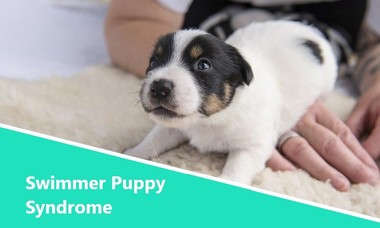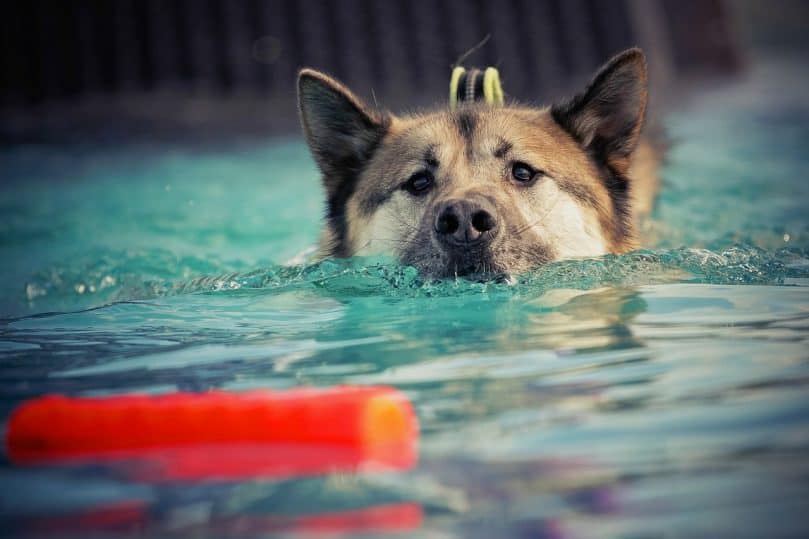This page contains affiliate links. We may earn money or products from the companies mentioned in this post through our independently chosen links, which earn us a commission. Learn More
 Swimmers syndrome is an uncommon development in dogs or cats, also known as flat-pup syndrome or swimming-puppy syndrome. This syndrome leads to a deformation in their limbs, beginning with the hind limbs. This type of deformational development makes the legs twisted and results in the inability to stand or walk.
Swimmers syndrome is an uncommon development in dogs or cats, also known as flat-pup syndrome or swimming-puppy syndrome. This syndrome leads to a deformation in their limbs, beginning with the hind limbs. This type of deformational development makes the legs twisted and results in the inability to stand or walk.
Don’t fret. We’ve prepared a thorough guide on what this rare condition is and how you can properly treat your pup to give her the best outcome possible for a long, happy life.
Contents & Quick Navigation
What is Swimmer Puppy Syndrome?
Swimmer Puppy Syndrome is a developmental deformity that results in a puppy having a flattened thorax/chest.
Noticeable just a few weeks after birth, the front, and hind limbs grow out to the side of the body, keeping the puppy in a permanent swimming position where the limbs can only move in a paddling motion.
Weak muscles make standing, walking, and running virtually impossible. If left untreated, this condition can lead to breathing and eating issues, joint problems, constipation, aspiration pneumonia, Patellar Luxation, as well as early death.
Fortunately, with early intervention, a dog with Swimmer Puppy Syndrome can overcome the physical challenges and grow up to walk, run, and live a mostly normal life.
You can get some inspiration from Starfish! With hard work, this dog overcame Swimmer Puppy Syndrome and won the hearts of many.
Symptoms & Causes of Swimmer Puppy Syndrome

This is a fairly uncommon syndrome, with little research and understanding in terms of what causes it in the first place.
Some medical professionals believe that Swimmer Puppy Syndrome is hereditary. If this is the case, an affected puppy should not be used for breeding purposes.
Others believe that it is not genetic at all, but merely congenital. This means that the deformity happens at random, in-utero-carriage via infection or due to some other abnormality.
Environmental factors are also of debate. It is said that by keeping a room too warm, a puppy will become overheated and lazy. The pup remains in a lying position for long periods of time nursing, devoid of regular movement to foster healthy muscle development.
If you notice the following symptoms, contact your vet immediately. The sooner you start therapy, the better chance your pup has of a full recovery.
- The puppy has a flat chest with the forelegs and hind legs permanently splayed out of the sides of the body. This is usually evident a week after birth.
- The puppy is unable to stand or walk by three weeks of age
- Because the chest flattens, the heart and other organs are pushed up into the pleural cavity. This makes breathing difficult, so the puppy will lack energy and appear lethargic.
Swimmer Puppy Syndrome is most commonly seen in small or dwarf dog breeds. Here is a list of notable breeds that have recurrent cases.
- Yorkshire Terriers
- English Cocker Spaniels
- Pekinese
- West Highland White Terriers
- English Bulldogs
- French Bulldogs
- Basset Hounds
- Dachshunds
Treatment Options for Swimmer Puppy Syndrome
Once upon a time, a wee little pup diagnosed with Swimmer Puppy Syndrome was viewed as a lost cause. It wasn’t (and still isn’t) uncommon to be told by a veterinarian that euthanization is the only course of action.
Don’t give up! There are now many innovative techniques and home therapies that can help an affected puppy overcome this unusual syndrome.
All she needs is for you to believe in her, and you’ll be surprised to see the fighting spirit in a dog hungry for life and the love of her owner.
The first step to treatment is beginning as soon as possible. The earlier you treat the symptoms, the more promising the outcome for your pup to live a healthy adult life.
Be prepared to dedicate a lot of time to rehabilitating your swimmer pup. Most importantly- and this one is crucial- stay CONSISTENT.
Home-care treatment is recommended, which involves three methods:
1. Environmental control
You’ll need to adjust your home to help foster a safe, muscle-strengthening environment for your little swimmer. The idea is never to lay her on a flat surface.
Keep your puppy on a non-slippery surface, so she can practice standing without falling about. Laying down carpet is one solution.
If you don’t have a carpet, egg crate liners have been shown to help promote ease of balance and increase traction. As well, you can confine your swimmer pup to an area where towels have been bunched up to prevent sliding.
Use cotton pads for the puppy to relieve herself on and change them frequently to keep the area clean.
Swimmer puppies tend to develop painful lesions on their bodies from laying in their urine and feces. Wipe her down regularly and apply baby powder to dry up any existing rashes.
2. Healthy diet
Watching your swimmer pup’s diet is necessary to ward off obesity. Too much weight gain will put unnecessary pressure on the joints. Do not allow her to nurse excessively.
You’ll have to help your pup to swallow food or milk by propping her up after eating and gently rubbing the belly to prevent regurgitation.
Ask your vet about introducing helpful supplements, such as Vitamin E or Selenium. I stress talking to your vet about this first because Selenium can be toxic if overdosed.
3. Physiotherapy

Physical movement has been shown to be a huge factor in healing Swimmer Puppy Syndrome. If not done, there is a slim chance that a swimmer pup will survive past eight weeks old.
There are many successful methods to try out- devise a plan with your vet for what works best for your pup- and then stick to it every day.
Massage therapy: Beginning each treatment with a full body massage will help relieve tension in the muscles and coaxes proper body alignment.
Supervision: Discourage positioning that promotes flatness. When the pup is sleeping, move her onto her side, so she is not splayed out. This also makes breathing easier for her.
Turn her over from time to time while she sleeps and eats when you can’t be with her. Strap a swimmer puppy syndrome harness on your pup to keep her chest well-suspended from the flat ground.
Swim sessions: Hit the pool three times a day. Swimming will help strengthen muscles without added pressure on the joints.
Stimulate: Those paw pads need stimulation! As mentioned, sling suspension helps the pup to get her paws on the ground, but you can also use a toothbrush to tickle those nerves and increase tactile sensation.
Sock method: This is similar to putting a life vest or harness on the pup. The idea is to keep the chest from being on a flat surface.
Take a sock and cut holes where the legs can come through, then let your pup wear it like a sweater. Stuff the chest area with foam to keep it elevated.
Sling & tape: Suspend your puppy in a sling, so she is kept in a standing position with her paw pads in contact with the floor.
Tape the legs in the correct position to encourage proper growth and put a cone on her neck if she tends to chew at the tape. This should be done from 15 to 20 minutes, 3 to 4 times a day.
Helping Your Dog Recover From Swimmer Puppy Syndrome

The prognosis for Swimmer Puppy Syndrome can seem scary, and in hindsight- it is a severe abnormality.
Remember, the earlier you notice symptoms, take her in for a diagnosis. The sooner you can start therapy, the better your pup’s chances of living a normal life!
If your vet tells you there’s no hope, get out of there and find a new vet! Swimmer Puppy Syndrome can improve with therapy, a proper diet, a safe environment, and an owner that has a lot of love to give.
You’ll need to devote a lot of time and energy to ensure your fur baby is comfortable. Aside from that, make sure she gets the exercise and hands-on massage she needs to help her breathe, swallow, and grow properly.
It’s up to YOU as the owner to jump into therapy and keep it up every day.
It may take hours, days, and weeks, but the payoff will be worth it when you see your pup stand and take her first steps after all of that dedication and hard work.
Share your stories about Swimmer Puppy Syndrome and help fellow dog owners! Just type it all on the comment box below.



5 replies on “Swimmer Puppy Syndrome: Symptoms, Causes & Treatment”
Thanks for the helpful information, can you please tell me does swimmers also affect the neck muscle the pups have,have no control over there heads flopping. They are maturing normally but their body functions are not. Going to the vet but I just was kind of wanting to get all the information I could first. Thank you
My minature Dachshund puppy was progressing extremely well until week 3 .
She lost 30g in weiht overnight which alerted me immediatley , emergency trip to the vet ,which to be honest was hopeless, they did thankfully refer us to the pet hospital.
Once there pup was hastily taken into their care whilst myself and my husband waited ,not so patiently !
Pup was diagnosed with pneumonia and swimmers syndrome. Prognosis wasn’t great to be honest.We left with antibiotics and to expect the worst !
Bonnie ! Is now 6.5 weeks old and can walk , yes she has her difficulties, I feed her separate to her siblings as she takes longer to eat,
Initial diagnosis stated that not many pups survive beyond 8 weeks, reading here has given me so much hope.
My golden retriever puppy was diagnosed with swimmer puppy syndrome when she was five weeks old . After taping her front paws and back paws for almost three weeks, she is able to walk and run now but her flat chest hasn’t improved . How can we correct the flat chest ?
Hi I have 4 puppies w swimers syndrome I just realize they have no teeth is this normal
Can you please post some pictures of how to best tape a puppy’s legs that has swimmers leg syndrome? My puppy has it in her front legs.